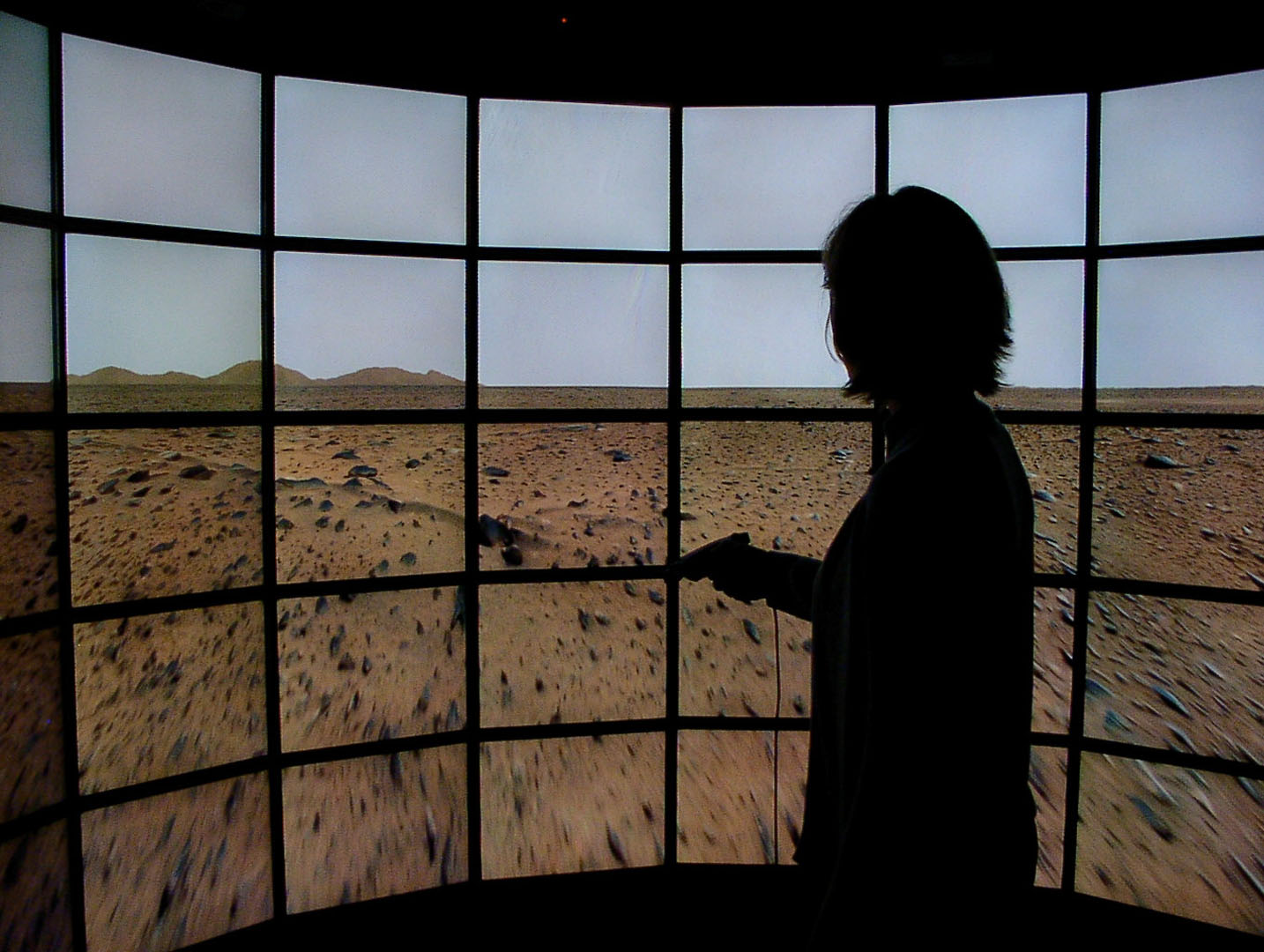“The VarrierTM autostereoscopic virtual reality display” by Sandin, Margolis, Ge, Girado, Peterka, et al. …
Conference:
Type(s):
Title:
- The VarrierTM autostereoscopic virtual reality display
Presenter(s)/Author(s):
Abstract:
Virtual reality (VR) has long been hampered by the gear needed to make the experience possible; specifically, stereo glasses and tracking devices. Autostereoscopic display devices are gaining popularity by freeing the user from stereo glasses, however few qualify as VR displays. The Electronic Visualization Laboratory (EVL) at the University of Illinois at Chicago (UIC) has designed and produced a large scale, high resolution head-tracked barrier-strip autostereoscopic display system that produces a VR immersive experience without requiring the user to wear any encumbrances. The resulting system, called Varrier, is a passive parallax barrier 35-panel tiled display that produces a wide field of view, head-tracked VR experience. This paper presents background material related to parallax barrier autostereoscopy, provides system configuration and construction details, examines Varrier interleaving algorithms used to produce the stereo images, introduces calibration and testing, and discusses the camera-based tracking subsystem.
References:
1. Cruz-Neira, C., Sandin, D., and Defanti, T. 1993. Surround-Screen Projection-Based Virtual Reality: The Design and Implementation of the CAVE. In Proceedings of ACM SIGGRAPH 1993, ACM Press / ACM SIGGRAPH, New York. Computer Graphics Proceedings, Annual Conference Series, ACM, 135–142. Google ScholarDigital Library
2. Cruz-Neira, C., Sandin, D., Defanti, T., Kenyon, R., and Hart, J. 1992. The CAVE: Audio Visual Experience Automatic Virtual Environment, Communications of the ACM, vol. 35, no. 6, 64–72. Google ScholarDigital Library
3. Dodgson, N. A., Moore, J. R., Lang. S. R., Martin, G., and Canepa, P. 2000. A 50″ Time-Multiplexed Autostereoscopic Display. In Proceedings of SPIE Symposium on Stereoscopic Displays and Applications XI, San Jose, California.Google Scholar
4. Fernando, R., and Kilgard. J. 2003. The CG Tutorial. Addison Wesley.Google Scholar
5. Girado, J. 2004. Real-Time 3d Head Position Tracker System With Stereo Cameras Using A Face Recognition Neural Network. PhD thesis, University of Illinois at Chicago. Google ScholarDigital Library
6. Girado, J., Sandin, D., Defanti, T., and Wolf, L. 2003. Real-time Camera-based Face Detection using a Modified LAMSTAR Neural Network System. In Proceedings of IS&T/SPIE’s 15th Annual Symposium Electronic Imaging 2003 Applications of Artificial Neural Networks in Image Processing VIII, San Jose, California, pp. 20–24.Google Scholar
7. He, D., Liu, F., Pape, D., Dawe, G., and Sandin, D. 2000. Video-Based Measurement of System Latency. International Immersive Projection Technology Workshop 2000. Ames, Iowa.Google Scholar
8. Ives, F. E. 1903. U. S. patent number 725–567.Google Scholar
9. Lipton, L., and Feldman, M. 2002. A New Autostereoscopic Display Technology: The SynthaGram. In Proceedings of SPIE Photonics West 2002: Electronic Imaging. San Jose, California.Google Scholar
10. Perlin, K., Paxia, S., and Kollin, J. 2000. An Autostereoscopic Display. In Proceedings of ACM SIGGRAPH 2000, ACM Press / ACM SIGGRAPH, New York. Computer Graphics Proceedings, Annual Conference Series, ACM, 319–326. Google ScholarDigital Library
11. Perlin, K., Poultney, C., Kollin, J., Kristjansson, D., and Paxia, S. 2001. Recent Advances in the NYU Autostereoscopic Display. In Proceedings of SPIE, vol. 4297, San Jose, California.Google Scholar
12. Sandin, D., Margolis, T., Dawe, G., Leigh, J., and Defanti, T. 2001. The Varrier Autostereographic Display. In Proceedings of SPIE, vol. 4297, San Jose, California.Google Scholar
13. Sandin, D., Sandor, E., Cunnally, W., Resch, M., Defanti, T., and Brown, M. 1989. Computer-Generated Barrier-Strip Autostereography. In Proceedings of SPIE, Three-Dimensional Visualization and Display Technologies, vol. 1083, pp. 65–75.Google Scholar
14. Schmidt, A. and Grasnick, A. 2002. Multi-viewpoint Autostereoscopic Displays from 4D-Vision. In Proceedings of SPIE Photonics West 2002: Electronic Imaging, San Jose, California.Google Scholar
15. Singh, R., Jeong, B., Renambot, L., Johnson, A., and Leigh, J. 2004. TeraVision: a Distributed, Scalable, High Resolution Graphics Streaming System, In Proceedings of Cluster 2004, San Diego, California. Google ScholarDigital Library
16. Son, J.-Y., Shestak, S. A., Kim, S.-S., Choi, Y.-J. 2001. Desktop Autostereoscopic Display with Head Tracking Capability. In Proceedings of SPIE Vol. 4297, Stereoscopic Displays and Virtual Reality Systems VIII, San Jose, California.Google Scholar
17. Sullivan, A. 2004. DepthCube Solid-State 3D Volumetric Display. In Proceedings of SPIE Electronic Imaging 2004, San Jose, California.Google Scholar
18. van Berkel, C. Image Preparation For 3D-LCD 1999. In Proceedings of SPIE Vol. 3639 Stereoscopic Displays and Virtual Reality Systems VI, San Jose, California.Google Scholar
19. van Berkel, C. and Clarke, J. A. 1997. Characterization and Optimization of 3D-LCD Module Design. In Proceedings of SPIE Vol. 3012, Stereoscopic Displays and Virtual Reality Systems IV, San Jose, California.Google Scholar
20. Winnek, D. F. 1968. U. S. patent number 3,409,351.Google Scholar





